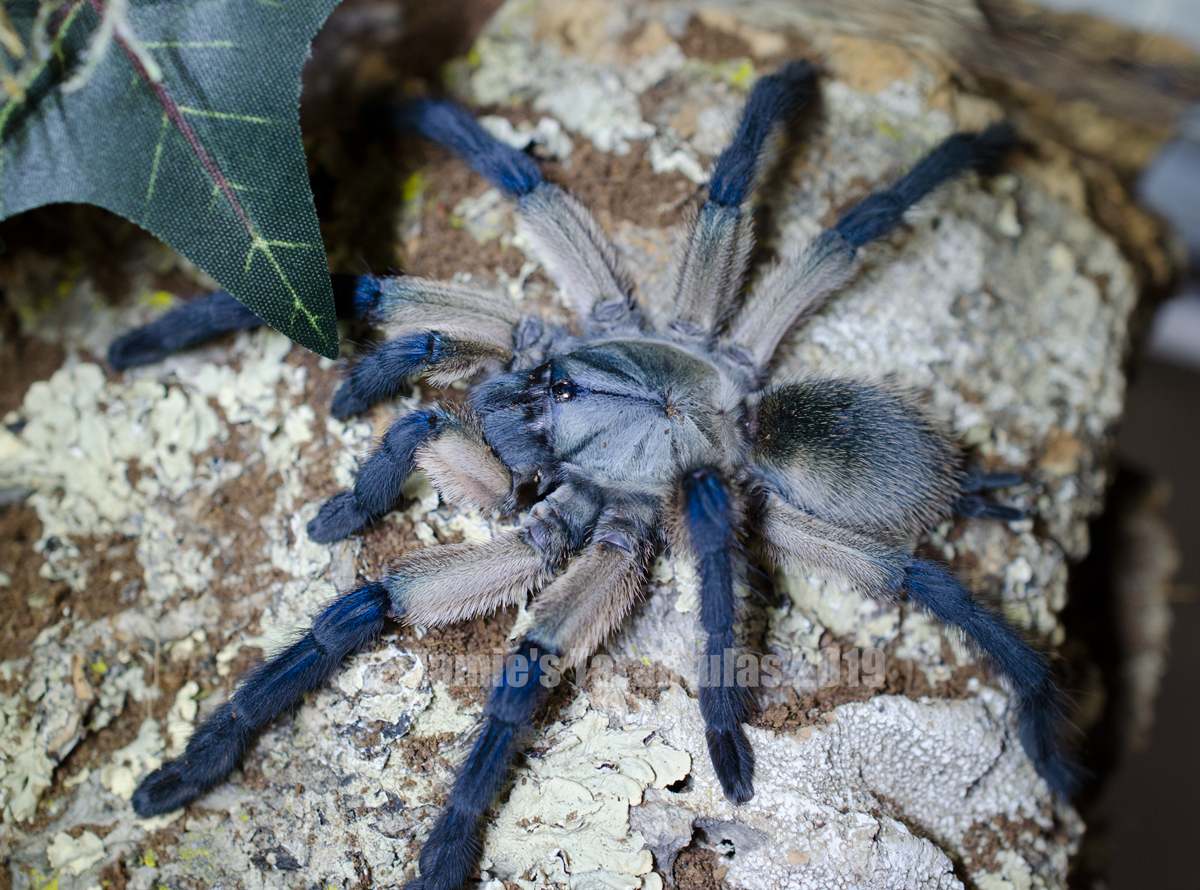This tarantula is as unique and amazing as the landscape it hails from. Due to Socotra's abundance of unusual endemic species the Island is often referred to as "The most alien-looking place on earth" ...and this extraordinary species is no exception!
Not only does the Socotra Island Blue Baboon possess such remarkable coloration, M. balfouri are one of the very few truly communal species. When done properly multiple M. balfouri can be housed in the same enclosure!
The Socotra Island Blue Baboon is an easy keeper who creates elaborate tube webs. This tarantula could make a good first Old World tarantula for the serious collector.
Spiderlings are slow to obtain their adult colors, but in my opinion experiencing the transformation is part of the fun of raising a tarantula. It will take a while, typically a year or more, but around 1 1/4-1 3/4" leg-span spiderlings will typically start showing the first signs of adult coloring. After 2" or so the specimens adult coloring is usually more prominent. Keep in mind these are estimates and it does vary from specimens to specimen. What a joy it is to witness the transformation of an unassuming grey spiderling into a large, blue and silver tarantula!
Origin: Old World. Native to Socotra, a unique & isolated island approximately 150 miles east of the horn of Africa.
Difficulty: High Intermediate to Advanced (Due to speed and bite potency)
Type: Terrestrial
Adult Size: 4.5-5.5"
Growth speed: Medium
Longevity: Males 4+ years, females 10-15 or more years
Temperament: Skittish and often defensive. If agitated they are typically more likely to flee but they can be defensive and bite if they feel threatened.
Bite potency: Strong
Urticating hairs: No
Ideal Temperature: 70 to 75°
Humidity: Medium
Interesting Fact: M. balfouri is one of the few truly communal species. I would even go as far to say they seem happier and healthier when kept as a proper communal. As of July 2020 I have three separate M. balfouri communal enclosures as part of my personal collection. I always look forward to feeding them!
For more information on keeping a M. balfouri communal:
Monocentropus balfouri - Assembling a Communal Enclosure - Part I
Monocentropus balfouri - Communal Maintenance - Part II
Enclosure: Good ventilation is a must and safety should be a top priority when choosing and designing your tarantulas enclosure. The enclosure should not be too tall as to give the spider an opportunity to fall and injure itself. For spiderlings under about 1-1 1/4" we recommend the Terrestrial Spiderling Enclosure Kit. For specimens over 1" to about 2" we recommend the Terrestrial Juvenile Enclosure Kit. Specimens over 2" and under about 4.5 or 5" can go into a 7x7x11" complete terrestrial enclosure. If you have a larger specimen or would like to be sure the final enclosure is definitely large enough we recommend the 8x8x14" Adult Complete Terrestrial for 2-2.5" and over specimens. Click HERE to find out how to you measure a tarantula.
Substrate: While most adults will adopt a hide, slings often prefer to burrow. Cocofiber, vermiculite, peat moss and/or potting soil (or a mix) are all excellent substrate choices. Please make sure the substrate you choose is organic and chemical/fertilizer free. Do not use sand, pebbles, rocks or wood chips or anything else that could potentially cut or injure the tarantula.
In many cases a larger specimen would rather adopt or retrofit an existing hide than create it's own from deep substrate. Cork tubes half buried in substrate are what we use for our adult females. The specimen will excavate one side of the cork tube to it's liking. I like to think this makes the tarantula feel “at home” while minimizing the time and effort for the spider to settle in.
Spiderlings will often desire to create their own home by excavating a burrow. A tarantula with this talent and preference for tunneling is referred to as an obligate burrower. To encourage this natural behavior we recommend semi-moist substrate at least twice, and ideally three times as deep as the tarantulas DLS. Both the Terrestrial Spiderling and Terrestrial Juvenile Enclosure Kit can be set up to encourage burrowing.
Water: Larger spiders 2” and over should be provided with a shallow water dish in order to drink. The water bowl should be rinsed our every time it is refilled. Being a scrubland species they will not require as frequent misting as an arboreal species however, I recommend keeping one corner of the enclosure lightly misted, especially if there is no water bowl.
Feeding: Adults will eat every 6-14 days depending on the size of the spider and it's prey. Spiderlings should eat more often, every 5-10 days. Adults may be fed crickets, mealworms or roaches. Spiderlings under .75” can only eat food small enough for it to overpower. This includes pinhead crickets, flightless fruit flies & freshly hatched "pinhead" rusty red roaches. It is not advised to feed your tarantula wild-caught food. It could contain parasites or pesticides that could be fatal to your pet. Keep your tarantulas enclosure clean. food waste left in the enclosure will invite mold, mildew, mites, flies and other pests. It is advised to remove uneaten prey items after 3-12 hours. If using a feeder who will not “bother” a tarantula such as dubia roaches it is alright to leave them in the enclosure as long as they are not causing stress to the specimen. A more detailed feeding, misting & troubleshooting guide can be found here: https://jamiestarantulas.com/guides/






Leave a Comment - Reply to